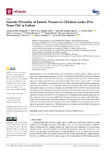2021-03-24Zeitschriftenartikel
Genetic Diversity of Enteric Viruses in Children under Five Years Old in Gabon
Manouana, Gédéon Prince
Nguema-Moure, Paul Alvyn
Ngwese, Mirabeau Mbong
Bock, C.-Thomas
Kremsner, Peter G.
Borrmann, Steffen
Eibach, Daniel
Mordmüller, Benjamin
Velavan, Thirumalaisamy P.
Niendorf, Sandra
Adegnika, Ayola Akim
Enteric viruses are the leading cause of diarrhea in children globally. Identifying viral agents and understanding their genetic diversity could help to develop effective preventive measures. This study aimed to determine the detection rate and genetic diversity of four enteric viruses in Gabonese children aged below five years. Stool samples from children <5 years with (n = 177) and without (n = 67) diarrhea were collected from April 2018 to November 2019. Norovirus, astrovirus, sapovirus, and aichivirus A were identified using PCR techniques followed by sequencing and phylogenetic analyses. At least one viral agent was identified in 23.2% and 14.9% of the symptomatic and asymptomatic participants, respectively. Norovirus (14.7%) and astrovirus (7.3%) were the most prevalent in children with diarrhea, whereas in the healthy group norovirus (9%) followed by the first reported aichivirus A in Gabon (6%) were predominant. The predominant norovirus genogroup was GII, consisting mostly of genotype GII.P31-GII.4 Sydney. Phylogenetic analysis of the 3CD region of the aichivirus A genome revealed the presence of two genotypes (A and C) in the study cohort. Astrovirus and sapovirus showed a high diversity, with five different astrovirus genotypes and four sapovirus genotypes, respectively. Our findings give new insights into the circulation and genetic diversity of enteric viruses in Gabonese children.
Files in this item

